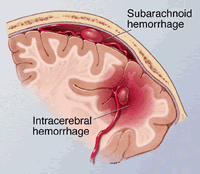|
|
Pathology definition - Subarachnoid hemorrhage

Subarachnoid hemorrhage.
There are a few causes of subarachnoid hemorrhage which include trauma, rupture of berry aneurysm and arteriovenous malformation. Subarachnoid hemorrhage may present with blood in the basal cistern which is proven with CT scan. Cerebral angiography is also another form of investigation.
Arteriovenous malformation commonly present in the subarachnoid space. Arteriovenous malformation is vascular malformation which is congenital in nature. Berry aneurysm present at the arterial bifurcation of the circle of the Willis. Berry aneursym is associated with neurofibromatosis type 1, hypertension, coarctation of the aorta, smoking, connective tissue disorder and autosomal dominant polycystic kidney disease. Berry aneurysm may thickening of the tunica intimal with absent of the tunica media at the vascular wall. There will be thinning of the tunica media at the neck of the aneurysm.
Patient who suffer from subarachnoid hemorrhage may complain of the worst headache of my life. Besides that they may present with symptoms and signs such as nausea, vomiting, ( seizures, hemorrhage- arteriovenous malformation), nuchal rigidity and alter in conscious level.
The treatment may include surgical repair as well as therapeutic and supportive/symptomatic care.
References
1.Bonita, R., and S. Thomson. “Subarachnoid Hemorrhage: Epidemiology, Diagnosis, Management, and Outcome.” Stroke 16, no. 4 (July 1, 1985): 591–594. doi:10.1161/01.STR.16.4.591.
2.Van Gijn, J., and G. J. E. Rinkel. "Subarachnoid haemorrhage: diagnosis, causes and management." Brain 124.2 (2001): 249-278.
There are a few causes of subarachnoid hemorrhage which include trauma, rupture of berry aneurysm and arteriovenous malformation. Subarachnoid hemorrhage may present with blood in the basal cistern which is proven with CT scan. Cerebral angiography is also another form of investigation.
Arteriovenous malformation commonly present in the subarachnoid space. Arteriovenous malformation is vascular malformation which is congenital in nature. Berry aneurysm present at the arterial bifurcation of the circle of the Willis. Berry aneursym is associated with neurofibromatosis type 1, hypertension, coarctation of the aorta, smoking, connective tissue disorder and autosomal dominant polycystic kidney disease. Berry aneurysm may thickening of the tunica intimal with absent of the tunica media at the vascular wall. There will be thinning of the tunica media at the neck of the aneurysm.
Patient who suffer from subarachnoid hemorrhage may complain of the worst headache of my life. Besides that they may present with symptoms and signs such as nausea, vomiting, ( seizures, hemorrhage- arteriovenous malformation), nuchal rigidity and alter in conscious level.
The treatment may include surgical repair as well as therapeutic and supportive/symptomatic care.
References
1.Bonita, R., and S. Thomson. “Subarachnoid Hemorrhage: Epidemiology, Diagnosis, Management, and Outcome.” Stroke 16, no. 4 (July 1, 1985): 591–594. doi:10.1161/01.STR.16.4.591.
2.Van Gijn, J., and G. J. E. Rinkel. "Subarachnoid haemorrhage: diagnosis, causes and management." Brain 124.2 (2001): 249-278.
